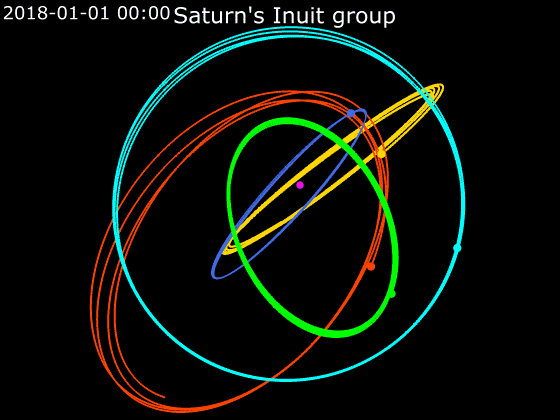Inuit Group on:
[Wikipedia]
[Google]
[Amazon]
 The
The
Preprint
/ref> and similar infrared spectra.Tommy Grav and
Preprint
/ref> Recent observations, however, revealed that Ijiraq is distinctly redder than Paaliaq, Siarnaq and Kiviuq. In addition, unlike the other three, Ijiraq's spectrum does not display weak absorption near 0.7 μm. This feature is attributed to a possible
Preprint
/ref> The
from JPL
{{DEFAULTSORT:Inuit Group Inuit group Moons of Saturn Irregular satellites Moons with a prograde orbit
 The
The Inuit
Inuit (; iu, ᐃᓄᐃᑦ 'the people', singular: Inuk, , dual: Inuuk, ) are a group of culturally similar indigenous peoples inhabiting the Arctic and subarctic regions of Greenland, Labrador, Quebec, Nunavut, the Northwest Territories ...
group is a dynamical grouping of the prograde irregular satellite
In astronomy, an irregular moon, irregular satellite or irregular natural satellite is a natural satellite following a distant, inclined, and often eccentric and retrograde orbit. They have been captured by their parent planet, unlike regular s ...
s of Saturn which follow similar orbit
In celestial mechanics, an orbit is the curved trajectory of an object such as the trajectory of a planet around a star, or of a natural satellite around a planet, or of an artificial satellite around an object or position in space such as ...
s. Their semi-major axes range between 11 and 18 Gm, their inclination
Orbital inclination measures the tilt of an object's orbit around a celestial body. It is expressed as the angle between a reference plane and the orbital plane or axis of direction of the orbiting object.
For a satellite orbiting the Eart ...
s between 40° and 50°, and their eccentricities between 0.15 and 0.48. They take about 2 years to orbit Saturn.
The International Astronomical Union
The International Astronomical Union (IAU; french: link=yes, Union astronomique internationale, UAI) is a nongovernmental organisation with the objective of advancing astronomy in all aspects, including promoting astronomical research, outreac ...
(IAU) uses names taken from Inuit mythology
Inuit religion is the shared spiritual beliefs and practices of the Inuit, an Indigenous peoples of the Americas, indigenous people from Alaska, northern Canada, parts of Siberia and Greenland. Their religion shares many similarities with some Al ...
for these moons.
The group appeared quite homogeneous in early observations, the satellites displaying ''light-red'' colour ( colour indices B−V = 0.79 and V−R = 0.51, similar to that of the Gallic group
The Gallic group is a dynamical grouping of the prograde irregular satellites of Saturn following similar orbits. Their semi-major axes range between 16 and 19 Gm, their inclinations between 35° and 40°, and their eccentricities around 0.53. ...
)Grav, Tommy; Holman, Matthew J.; Gladman, Brett J.; Aksnes, Kaare ''Photometric survey of the irregular satellites'', Icarus, 166,(2003), pp. 33–45Preprint
/ref> and similar infrared spectra.Tommy Grav and
Matthew J. Holman
Matthew J. Holman (born 1967) is a Smithsonian Astrophysical Observatory, Smithsonian astrophysicist and lecturer at Harvard University. Holman studied at MIT, where he received his bachelor's degree in mathematics in 1989 and his PhD in planetar ...
''Near-Infrared Photometry of the Irregular Satellites of Jupiter and Saturn'',The Astrophysical Journal, 605, (2004), pp. L141–L144Preprint
/ref> Recent observations, however, revealed that Ijiraq is distinctly redder than Paaliaq, Siarnaq and Kiviuq. In addition, unlike the other three, Ijiraq's spectrum does not display weak absorption near 0.7 μm. This feature is attributed to a possible
water
Water (chemical formula ) is an Inorganic compound, inorganic, transparent, tasteless, odorless, and Color of water, nearly colorless chemical substance, which is the main constituent of Earth's hydrosphere and the fluids of all known living ...
hydration.Tommy Grav and James Bauer ''A deeper look at the colors of Saturnian irregular satellites''Preprint
/ref> The
spectral
''Spectral'' is a 2016 3D military science fiction, supernatural horror fantasy and action-adventure thriller war film directed by Nic Mathieu. Written by himself, Ian Fried, and George Nolfi from a story by Fried and Mathieu. The film stars ...
homogeneity (with the exception of Ijiraq) is consistent with a common origin in the break-up of a single object but the dispersion of the orbital parameters requires further explanation. Recently reported secular resonances among the members could provide the explanation of the post-collisional dispersion.
Names
The known members of the group are (in order of increasing distance from Saturn): * S/2019 S 1 *Kiviuq
Kiviuq (also spelled "Qiviuq", "Kiviok" and other variants) is a legendary hero of the epic stories of the Inuit of the Arctic regions of northern Canada, Alaska and Greenland.
Kiviuq is an eternal Inuit wanderer. Spirits, giants, cannibals, bea ...
* Ijiraq
* Paaliaq
Paaliaq is a prograde irregular satellite of Saturn. It was discovered by J. J. Kavelaars, Brett J. Gladman, Jean-Marc Petit, Hans Scholl, Matthew J. Holman, Brian G. Marsden, Philip D. Nicholson and Joseph A. Burns in early October 2000, and gi ...
* Saturn LX
* S/2004 S 31
* Tarqeq
* Siarnaq
Siarnaq, also designated Saturn XXIX, is the second-largest irregular moon of Saturn. It was discovered on 23 September 2000 by a team of astronomers led by Brett J. Gladman. It was named after the Inuit goddess of the sea, Siarnaq, who is more ...
See also
*List of natural satellites
The Solar System's planets, and its most likely dwarf planets, are known to be orbited by at least 221 natural satellites, or moons. At least 20 of them are large enough to be gravitationally rounded; of these, all are covered by a crust of ...
References
External links
Mean orbital parametersfrom JPL
{{DEFAULTSORT:Inuit Group Inuit group Moons of Saturn Irregular satellites Moons with a prograde orbit